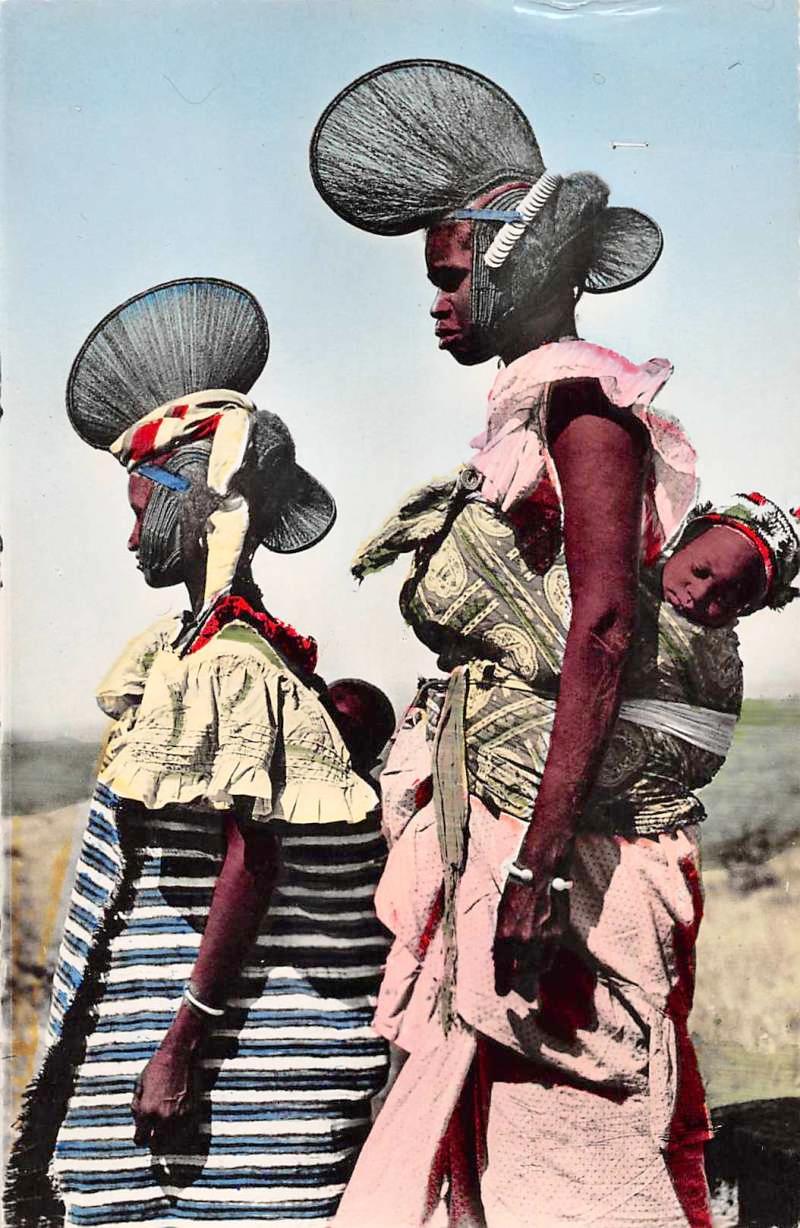
Guinean Ethnicity

Figure 1.--This postcard shoes Guinea mothers and babies in their octuresque traditional dress. We are not sure about the tribe yet, but they are from the Fouta Djallon region in the central highlands. These destinctive atire was still common in the mid-20th century, but has gradually declines agter World War II and decolonization..
|
|
There are about 25 tribal groups in Guinea. The three most important are the Fulani, Malinké, and Soussou. The Fulani (Peul) are the largest tribe, about 35 percent of the population and are concentrated in the Futa Jallon highlands region. Fouta Djallon is located roughly in the center of the country. he indigenous name in the Pular language is Fuuta Jaloo, originating from the Fula word for the region and the name of the original inhabitants, the Yalunka or Jalonke, a Mande people related to the Susu. The Malinké (Mandingo) are the second most important (about 30 percent) inhabiting the savanna of Upper Guinea and the Forest region. The Soussou (Susus) are a smaller group (about 20 percent). Their language Susu is commonly spoken in the coastal areas, including the capital, Conakry. Westerners thus sometimes refer to it as a lengua franca, but it is not eidely understood in the interior. . The percentages are estimates and various sources differ. Smaller groups, mostly from the Forest Region, includ the Bassari, Coniagui, Guerze, Kissi, Kono, and Toma. Bagas (including Landoumas), and Koniagis are found in the coastal area. Rather than reducing tribal loyalties and tension as Guinea became a new nation, tribal conflit has increased since independence. Each of Guinea’s first three leaders, all dictastors, pursued policies of delivering posts and contracts to members of their own ethnic group and directging investment and infrastruvctire in their own home region. And while these leaders became unpopular, they gained popularity in the areas they favored which still lingets to this day. Captain Dadis was a particulrly brutal man and dictstor. He was of the small Guerze tribe from the Forest Region and continues to be beloved there for improving better roads, social services, and electricity during his brief reign. And even vandidates in the country's first democratic elections also exploited the ethnic divide. Fulani presidential candidate, Cellou Dalein Diallo, won nearly 45 percent f the vote in the first round, The next closest opponent, the Malinké candidate Alpha Condé, won less than 20 prcent. Critics of President Condé chsrge thast he rigged the final vote as he won a narrow majority. His election slogans and the importance of ethnic-based voting, suggest that Condé’s victory resulted from uniting the other ethnic groups against the Fulani.
HBC

Navigate the Boys' Historical Clothing Web Site:
[Introduction]
[Activities]
[Biographies]
[Chronology]
[Cloth and textiles]
[Clothing styles]
[Countries]
[Topics]
[Bibliographies]
[Contributions]
[FAQs]
[Glossaries]
[Images]
[Links]
[Registration]
[Tools]
[Boys' Clothing Home]
Navigate the Boys' Historical Clothing national pages:
[Return to the Main Guinea page ]
[Return to the Main African country page]
[Cape Verde Islands]
[Democratic Republic of the Congo]
[Gabon]
[Guinea-Bissau]
[Ivory Coast]
[Lessotho]
[Liberia]
[Madagascar]
[Mali]
[Senegal]
[Sierra Leone]
]South Africa]
[Uganda]
[France]
Created: 7:28 AM 7/3/2017
Last updated: 7:28 AM 7/3/2017



